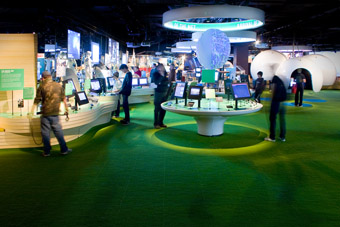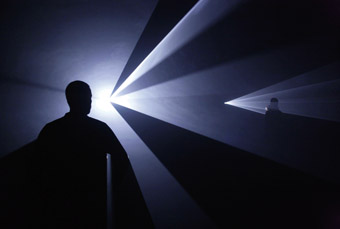an eye on screen history
wendy haslem: screen worlds, acmi

Emergence, Screen Worlds installation
photo Travis de Clifford
Emergence, Screen Worlds installation
ON A DRIZZLY, GREY SEPTEMBER MELBOURNE MORNING THE GLAMOROUS AND COSY CATE BLANCHETT, DRESSED IN OFF-THE-SHOULDER CROCHET, CUT A RIBBON OF CELLULOID TO LAUNCH THE AUSTRALIAN CENTRE FOR THE MOVING IMAGE’S PERMANENT, FREE ADMISSION SCREEN WORLDS EXHIBITION. A BIG CROWD STREAMED IN TO SEE THIS HIGHLY ANTICIPATED SHOW, ONE DESIGNED TO DEPICT THE EVOLUTION OF FILM, TELEVISION AND DIGITAL CULTURE.
Organised across three rooms focusing on Emergence, Voices and Sensation, the past, present and future of the moving image is traced across time and framed within an international matrix. A combination of white cube and black box, Screen Worlds incorporates objects designed for the eye with dynamic interactive touch screens.
Emergence is divided into six table displays featuring the arrival of film, sound and colour, television, global broadcast, video games and the internet with each world identified by a circular banner hovering above the exhibits. Emergence is full of objects, screens, still and moving images and even machines, so the banners are integral in providing a sense of cohesion. Wall displays illustrate and expand on the connections providing satellite examples of innovation specific to the era. Precious artefacts representing optical experimentation and pre-cinematic devices include an exquisite collection of Chinese shadow puppets from the late 19th century and a magic lantern complete with slides and the projected illusion of a ship bobbing on an ocean. Peep boxes display single shot ‘actualities’ like Annabelle’s Skirt Dance (WKL Dickson,1896), the flowing robes evidence of the fascination with the particulars of movement in early cinema.
Technological illusion generates “an aesthetic of astonishment”, a phrase coined by the film theorist Tom Gunning to describe the wonder of the illusion and pre-cinematic optical technologies. A range of interactive screens engage the senses. On one visit I noticed a small child letting his fingers lead him through the space, pausing at moments when his touch created action.
One interactive screen invites participants to investigate locations filmed with cameras exported by the Lumière brothers. Touch screens reveal sequences from the 1896 Melbourne Cup, Japanese sword fighting and Italy’s Grand Canal. Vivid colour reproductions of the Salvation Army’s Soldiers of the Cross (1900) sit alongside sequences from the first film produced in Australia, The Kelly Gang (1906), its imagery layered with the bubbling of decomposing nitrate film stock. This film is juxtaposed with Gregor Jordan’s 2003 version of Ned Kelly, forming sequences of diachronic associations.
The diversity of early cinema is represented by the mesmerising rhythms and imagery of key modernist films including Man Ray’s Le Retour à la Raison (1923) and Fernand Léger’s Ballet Méchanique (1924). A big screen shows scenes from epic films designed to generate nationalistic fervour. Sequences include the slaying of a gigantic mythological creature from Fritz Lang’s Die Nibelungen (1924), mass crowds from Giovanni Pastrone’s ‘super spectacle’ Cabiria (1914) and magical images of characters flying through the air on giant spears from Hou Yao’s Tale of the Western Chamber (1927).
The section celebrating the arrival of sound and colour features a Steenbeck film viewing machine that allows participants to wind celluloid through sprockets to discover the speed of sound film, 24 frames per second. A thick MGM disc, The Hollywood Review Trailer (1929) is a quirky example of early attempts to synchronise sound to the projected image, but the unique value of this artefact is evident in detail on the label revealing that the disc has only been used once.
A lucite television set created for display at the New York World’s Fair in 1939 announces the arrival of TV. Its transparent façade renders visible an intricate system of valves and wires. The diversity of local voices is emphasised with exhibits like “Finding a Voice”, a touch screen collection of sequences representing documentary explorations of Australian Indigenous cultures. Wrong Side of the Road (Ned Lander, 1983) and Two Laws (1981) by the Booroloola Aboriginal community are the highlights of this collection. The impact of popular culture is evident in Bongo Starr’s boots encased in glass in front of a portable Princess Seven television screening his glam rock band Skyhooks on Countdown. The same screen also displays the self-reflexive chaos characteristic of The Aunty Jack Show (1972-3) as characters greet the transition to colour washing over the small screen by attempting to swim through the flood. Animation, comics, posters and a sleeping action figure of Astro Boy showcase an early example of media convergence. The extension of the global village into the skies is illustrated by fuzzy black and white images of the 1969 moon landing alongside screens depicting the astonishment of audiences watching live. Influence of the space race is evident in the JVC Videosphere TV from 1970, a spherical television set with curved screen resembling an astronaut’s helmet.
The room showcasing Australian Voices contains large, stunning objects like the Interceptor car from Mad Max (1979), Dame Edna’s sequined Sydney Harbour dress and a windmill from Baz Luhrmann’s Moulin Rouge (2001). An interactive map spread across a large table represents Australian film locations where sites can be illuminated by touch. A showcase of Australian films represented as a collection of small slides allows for an interactive investigation of specific film, television, visual art and digital images. Curated by Indigenous cultural advisors, the Blak Wave exhibit includes records and cassettes by artists like The Warumpi Band alongside Indigenous television programs. Smaller enclaves representing the work of specific filmmakers fringe the edges of the room. The spaces spotlight Tracy Moffatt, Animal Logic, Christopher Doyle, Jill Bilcock, Baz Luhrmann and Catherine Martin, Cate Blanchett, David Gulpilil and Rolf de Heer (whose space includes a canoe!). Scripts, awards and photo albums are archived here, but the magic is in the inclusion of trinkets like rocks and a tiny model motorbike with sidecar, talismans used by screenwriting team Sue Smith and John Alsop.
A games lab leading into the Sensation space features small screens where participants can play classic games like Bejewelled, Half Life, Lemmings and Tetris and design creatures for the beautiful underwater world of Spore. A big screen invites a public challenge in a range of interactive Wii games. Sensation draws together new and older technologies and it is here that the visitor can become immersed in illusions created by new media. Ty the Tasmanian tiger forms part of an Australian themed Zoetrope. Inspired by Eadweard Muybridge’s experiments with time and motion, the ‘flicker fusion effect’ invites visitors to create their own flipbook. The Matrix-style time slice installation uses 36 cameras to capture the action of participants and transmits the video clip via email. Philip Worthington’s Shadow Monsters (2005) adds beaks, claws, scales, horns, teeth, puffs of smoke and wispy strands of hair to silhouettes of bodies, transforming humans into prehistoric animals.

You and I, Horizontal II, Anthony McCall
photo courtesy ACMI
You and I, Horizontal II, Anthony McCall
But the most astonishing immersive installation is kept until last. Behind a curtain at the end of the Sensation area, Anthony McCall’s You and I, Horizontal II from 2006 combines a haze machine with a video projection of solid white light to immerse participant and installation. I noticed that same young boy who greeted the exhibits with a touch earlier, now swimming in the hazy light, his head and arms illuminated by the white neon.
Until the opening of Screen Worlds, the single exhibit occupying ACMI’s ground floor was the Academy Award for Harvie Krumpet (Adam Elliot, 2003). Now this luminous award sits at the heart of Screen Worlds surrounded by relics, machines, screens, games, sounds, light and illusion, an impressive and dynamic history of the moving image.
Screen Worlds: The Story of Film, Television and Digital Culture, free, permanent exhibition, Australian Centre for the Moving Image, Melbourne, opened Sept 20, www.acmi.net.au
RealTime issue #94 Dec-Jan 2009 pg. 24






